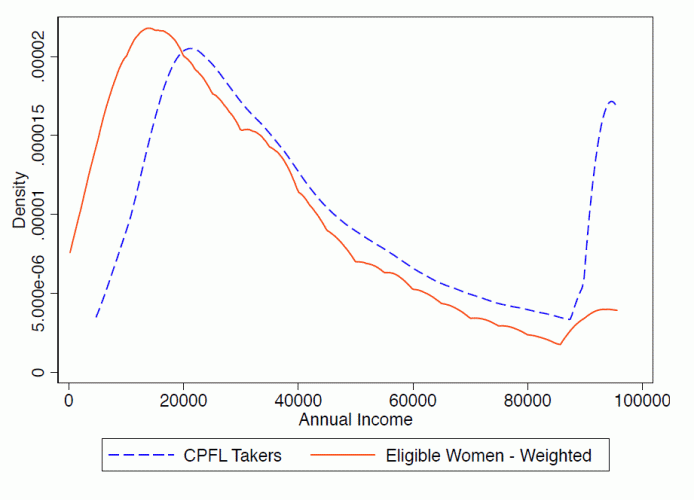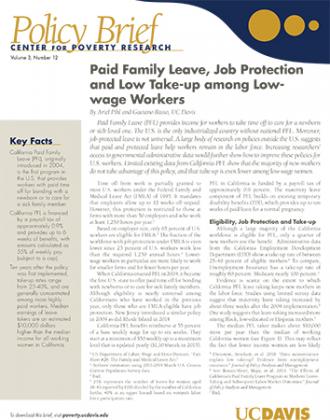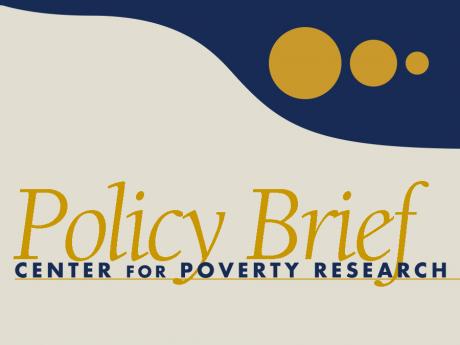Paid Family Leave, Job Protection and Low Take-up among Low-wage Workers
By Ariel Pihl and Gaetano Basso, UC Davis
Paid Family Leave (PFL) provides income for workers to take time off to care for a newborn or sick loved one. The U.S. is the only industrialized country without national PFL. Moreover, job-protected leave is not universal. A large body of research on policies outside the U.S. suggests that paid and protected leave help workers remain in the labor force. Increasing researchers’ access to governmental administrative data would further show how to improve these policies for U.S. workers. Limited existing data from California PFL show that the majority of new mothers do not take advantage of this policy, and that take-up is even lower among low-wage women.
Time off from work is partially granted to most U.S. workers under the Federal Family and Medical Leave Act (FMLA) of 1993. It mandates that employers allow up to 12 weeks off unpaid. However, this protection is restricted to those at firms with more than 50 employees and who work at least 1,250 hours per year.[1]
Key Facts
- California Paid Family Leave (PFL), originally introduced in 2004, is the first program in the U.S. that provides workers with paid time off for bonding with a newborn or to care for a sick family member.
- California PFL is financed by a payroll tax of approximately 0.9% and provides up to 6 weeks of benefits, with amounts calculated as 55% of weekly pay (subject to a cap).
- Ten years after the policy was first implemented, take-up rates range from 25-40%, and are generally concentrated among more highly paid workers. Median earnings of leave takers are an estimated $10,000 dollars higher than the median income for all working women in California.
Based on employer size, only 65 percent of U.S. workers are eligible for FMLA.[2] The fraction of the workforce with job protection under FMLA is even lower since 23 percent of U.S. workers work less than the required 1,250 annual hours.[3] Lower-wage workers in particular are more likely to work for smaller firms and for fewer hours per year.
When California enacted PFL in 2004, it became the first U.S. state to offer paid time off for bonding with newborns or to care for sick family members. Although eligibility is nearly universal among Californians who have worked in the previous year, only those who are FMLA-eligible have job protection. New Jersey introduced a similar policy in 2009 as did Rhode Island in 2014.
California PFL benefits reimburse at 55 percent of a base weekly wage for up to six weeks. They start at a minimum of $50 weekly up to a maximum level that is updated yearly ($1,104/week in 2015). PFL in California is funded by a payroll tax of approximately 0.9 percent. The maternity leave component of PFL builds on existing temporary disability benefits (TDI), which provides up to ten weeks of paid leave for a normal pregnancy.
Eligibility, Job Protection and Take-up
Although a large majority of the California workforce is eligible for PFL, only a quarter of new mothers use the benefit. Administrative data from the California Employment Development Department (EDD) show a take-up rate of between 25-40 percent of eligible mothers.[4] To compare, Unemployment Insurance has a take-up rate of roughly 80 percent. Medicare nearly 100 percent.[5]
Evidence is scarce on the extent to which California PFL leave taking keeps new mothers in the labor force. Studies using limited survey data suggest that maternity leave taking increased by about three weeks after the 2004 implementation.[6] One study suggests that leave-taking increased more among Black, low-educated or Hispanic mothers.[7]
The median PFL taker makes about $10,000 more per year than the median of working California women (see Figure 1). This may reflect the fact that lower income women are less likely to be eligible for FMLA. Our calculations suggest that women who didn’t complete high school are 11 percentage points less likely to be eligible for FMLA than the average and 26 percentage points less likely than women with a college degree.[8]
Awareness of the PFL program may also be low. According a 2011 study,[9] only half of surveyed adults who had an eligible life event knew about the policy. Some workers who knew about the policy feared employer punishment, or said that the replacement rate was too low.
Family Leave Outside the U.S.
Studies on PFL outside the U.S. suggest some ways the policy affects workers and labor markets. Family leave outside the U.S. is more generous in terms of both benefits (e.g., up to 100% of income in Germany for the first 14 weeks of leave) and job protection (e.g., up to 1 year in the UK). Recent high-quality research on these programs benefits from large, anonymized administrative datasets that cover the entire workforce. This kind of data is not typically made available on U.S. workers.
A 2014 study[10] shows that an Austrian reform which reduced the duration of paid benefits from 24 to 18 months, while keeping job protection unchanged, induced a drop in leave taking by 3.4 months on average. This suggests that new mothers would take advantage of more generous policies if available. The study also suggests that only the combination of job protection and benefits generates both longer leave taking and a larger probability of returning to work.
A 2015 study[11] on Norway’s PFL finds large effects of paid leave on employment and earnings five years after birth for mothers who took little to no unpaid leave before paid leave was available. Although not precisely estimated, paid leave increased the likelihood that high school dropout mothers returned to work compared to mothers with more education. Norway’s maternity leave policies before the introduction of PFL in the late 1970s were similar to U.S. policies today: working mothers had access to 12 weeks of unpaid leave.
Need for Data and Research on U.S. Policies
Research on PFL from other countries has largely advanced our knowledge of its impact on working mothers. However, in the U.S. paid leave is limited and protected leave is not universal.
As California PFL begins its second decade and other jurisdictions follow suit, it is important to study the take-up of these benefits and their effects on mothers’ time away from and return to work. Early evidence from California suggests that it may be particularly important to monitor eligibility and use of these benefits by low-income women.
Ariel Pihl and Gaetano Basso are Ph.D. candidates in Economics at UC Davis.
[1] US Department of Labor, Wage and Hour Division. “Fact Sheet #28: The Family and Medical Leave Act.”
[2] Authors’ estimation using 2011-2014 March U.S. Census Current Population Survey data.
[3] Ibid.
[4] 25% represents the number of leaves for women aged 18-45 reported by EDD divided by the number of California births; 40% is an upper bound based on women’s labor force participation rate.
[5] Ebenstein, Avraham, et al. 2010. “Does inconvenience explain low take-up? Evidence from unemployment insurance.” Journal of Policy Analysis and Management.
[6] See: Rossin-Slater, Maya, et al. 2013. “The Effects of California’s Paid Family Leave Program on Mothers’ Leave-Taking and Subsequent Labor Market Outcomes.” Journal of Policy Analysis and Management.
[7] Ibid.
[8] Authors’ own calculations using March CPS (2011-2014).
[9] Milkman, Ruth, et al. 2011. “Leaves that pay: Employer and worker experiences with paid family leave in California.” Center for Research on Economic Policy.
[10] Lalive, Rafael et al. 2014. “Parental leave and mothers’ careers: The relative importance of job protection and cash benefits.” The Review of Economic Studies.
[11] Carneiro, Pedro, et al. 2015. “A Flying Start? Maternity Leave Benefits and Long-Run Outcomes of Children.” Journal of Political Economy.
#povertyresearch












